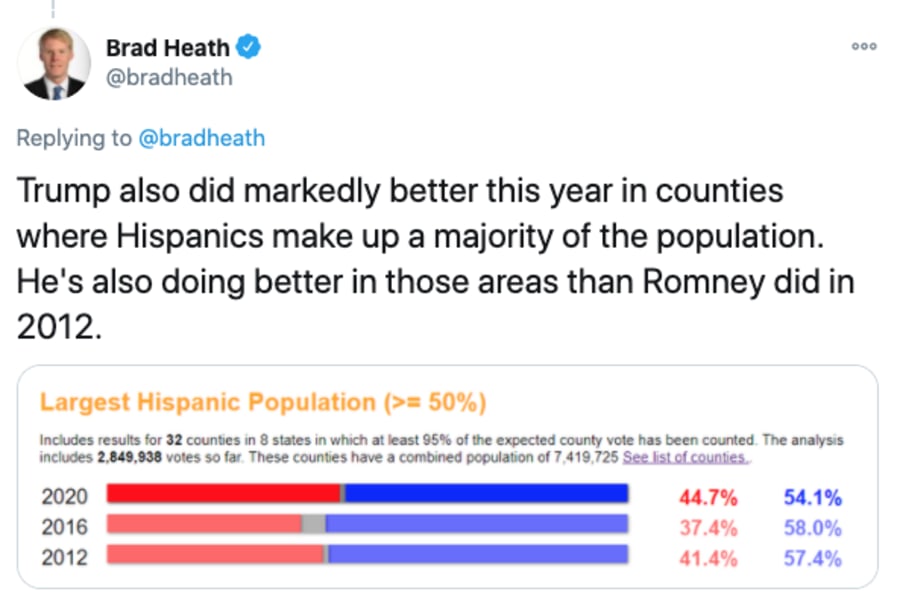SAN ANTONIO – While the top of the ticket is still being ironed out (and might be for a while longer), the dust has mostly settled around San Antonio and Texas following Tuesday’s general election.
As muddy as the presidential results might be, there is plenty of clarity in Texas about where voters stand.
Recommended Videos
Here’s what we learned on Election Day in Texas.
1. Texas Democrats got absolutely demolished
After months of chatter about how Texas was finally a battleground state, voters made a resounding statement to the contrary up and down the entire ballot.
At the top, Joe Biden lost by about six percentage points - doubling the margin that Beto O’Rourke lost by to U.S. Sen. Ted Cruz in 2018. Hillary Clinton lost Texas by nine points to Trump in 2016, but polling in the months leading up to the race suggested it was a dead heat going into early voting.
Texas Democrats also were hoping to be in the national conversation around control of the U.S. Senate and House following favorable polling and massive early turnout. But Mary “MJ” Hegar was easily defeated by Sen. John Cornyn. And U.S. House races that were expected to be competitive — like District 21 and 23 around San Antonio — turned out to be a not-so-close victory for Republicans.
All told, Texas Democrats picked up zero seats in the U.S. House and Senate after hoping they could get close to 10.
To add insult to injury, Dems also picked up a net gain of zero in the Texas House. They were hoping to flip the 150-member lower chamber - needing 9 pickups to do so.
In San Antonio, Texas House District 121 was the one being targeted by state Dems. But the rematch between state Rep. Steve Allison and Celina Montoya fizzled with an eight-point victory for the GOP.
Texas Democrats did flip a state Senate seat in San Antonio in the form of Roland Gutierrez, but the Senate District 19 was held by Democrats for decades before incumbent Pete Flores flipped it in a special election after 2016.
2. Bexar County is a blue dot in a sea of red
As was the case in most of the country, metro areas like San Antonio (Bexar County) bled blue while the less-populated rural areas were decidedly Trump supporters.
The county-by-county view of the electoral map shows the divide between city slickers and their rural neighbors. To apply a phrase from former Gov. Rick Perry, Bexar County is the blueberry in a tomato soup.
To make matters worse yet for Texas Democrats, the counties surrounding Bexar County grew darker red in 2020 from their hue in 2016. The first map in the embed below shows 2016 numbers, followed by 2020 numbers.
3. Trump ascends in Rio Grande Valley
In an area that typically acts as a blue (border) wall, the Rio Grande Valley shocked local, state and national analysts as Trump made huge gains over his (and former GOP presidential candidates) past performance there.
While most of the Valley counties — and others northwest of them along the border — were secured by Biden, the slim margins had many doing a double-take.
Take Starr County, for example. The border county is 96% Hispanic and one of the poorest in the nation. In 2016, Trump lost to Clinton there by a huge margin - only grabbing 19% of the vote. This time around, Trump pulled in more than double that number: 47%, according to The Monitor.
Trump won Zapata County, as Texas Tribune political reporter Patrick Svitek noted last night, and U.S. Rep. Vicente Gonzalez won reelection in his RGV district by just 3 points after a resounding 21-point victory in 2018.
Trump has won Zapata County — just north of the Rio Grande Valley along the border — by 6 points, 53% to 47%, per SOS results.
— Patrick Svitek (@PatrickSvitek) November 4, 2020
Last two presidential elections there were Clinton +33 and Obama +43.
With all precincts reporting per SOS, @RepGonzalez has won reelection to his solidly Dem district by just under 3 points. That's quite the narrowing after he won by 21 in 2018, and another sign of Dem problems in the Rio Grande Valley tonight.
— Patrick Svitek (@PatrickSvitek) November 4, 2020
Trump’s growing popularity among Hispanic voters wasn’t limited to Texas' RGV.

4. Bexar County voters made historic choices for women
Democrat Kathryn Brown became the first Black woman ever elected as a Bexar County Constable on Tuesday and, for the first time ever, the Bexar County Commissioners Court will include two female commissioners alongside two male colleagues (the county judge, Nelson Wolff, also has a seat on the court). Previously, only two women have ever served in a commissioner role.
In Precinct 1, Democrat Rebeca Clay-Flores defeated Republican Gabriel Lara with 65% of the vote. She will take over Sergio “Chico” Rodriguez’s long-held seat on the Commissioners Court.
And in Precinct 3, Republican Trish DeBerry will fill the Commissioners Court seat of Kevin Wolff, who is retiring. DeBerry defeated Democrat Christine Hortick with 55% of the votes.
Brown defeated Republican Larry Ricketts in the race for constable in Precinct 4 with 61% of the votes.




